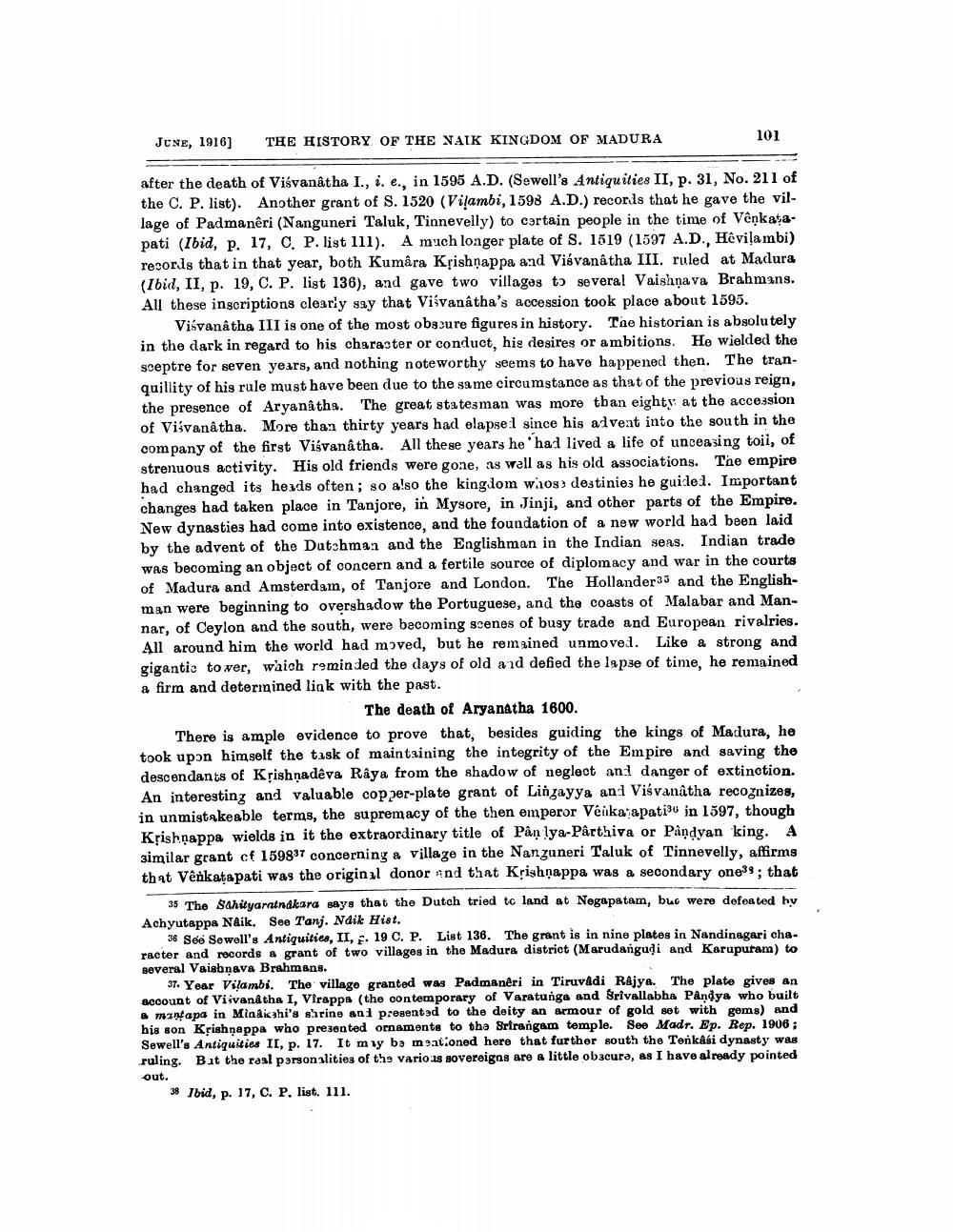________________
JCNE, 1916]
THE HISTORY OF THE NAIK KINGDOM OF MADURA
101
after the death of Visvanatha I., i. e., in 1595 A.D. (Sewell's Antiquities II, p. 31, No. 211 of the C. P. list). Another grant of S. 1520 (Vilambi, 1598 A.D.) records that he gave the village of Padmanêri (Nanguneri Taluk, Tinnevelly) to certain people in the time of Venkatapati (Ibid, p. 17, C. P. list 111). A much longer plate of S. 1519 (1597 A.D., Hevilambi) resoris that in that year, both Kumâra Krishnappa and Visvanatha III. ruled at Madura (Ibid, II, p. 19, C. P. ligt 136), and gave two villages to several Vaishnava Brahmans. All these inscriptions clearly say that Visvanatha's accession took place about 1595.
Visvanatha III is one of the most obgsure figures in history. The historian is absolutely in the dark in regard to his character or conduct, his desires or ambitions. He wielded the sceptre for seven years, and nothing noteworthy seems to have happened then. The tranquillity of his rule must have been due to the same circumstance as that of the previous reign, the presence of Aryanaths. The great statesman was more than eighty at the accession of Visvanatha. More than thirty years had elapse:1 since his advent into the south in the company of the first Visvanatha. All these years he had lived a life of unceasing toil, of strenuous activity. His old friends were gone, as well as his old associations. The empire had changed its heads often; so also the kingdom wnos) deztiniehe guide:1. Important changes had taken place in Tanjore, in Mysore, in Jinji, and other parts of the Empire. New dynasties had come into existence, and the foundation of a new world had been laid by the advent of the Dutchman and the Englishman in the Indian seas. Indian trade was becoming an object of concern and a fertile source of diplomacy and war in the courts of Madura and Amsterdam, of Tanjore and London. The Hollander35 and the Englishman were beginning to overshadow the Portuguese, and the coasts of Malabar and Mannar, of Ceylon and the south, were becoming scenes of busy trade and European rivalries. All around him the world had moved, but he remained unmoved. Like a strong and gigantic to ver, waich reminded the days of old and defied the lapse of time, he remained a firm and determined link with the past.
The death of Aryanatha 1600. There is ample evidence to prove that, besides guiding the kings of Madura, he took upon himself the task of maintaining the integrity of the Empire and saving the descendants of Krishnadeva Raya from the shadow of neglect an: danger of extinction. An interesting and valuable copper-plate grant of Lingayya and Visvanatha recognizes, in unmistakeable terms, the supremacy of the then emperor Veika apatiu in 1597, though Krishnappa wields in it the extraordinary title of Pân lya-Pârthiva or Pandyan king. A similar grant cf 159837 concerning a village in the Nanzuneri Taluk of Tinnevelly, affirms that Venkata pati was the original donor and that Krishnappa was a secondary ones; that
35 The Sahityaratndkara says that the Dutch tried to land at Negapatam, buo were defeated hy Achyutappa Naik. See Tanj. Ndik Hist.
36 Seo Sewell's Antiquities, II, F. 19 C. P. List 136. The grant is in nine plates in Nandinagari character and records a grant of two villages in the Madura district (Marudangudi and Karupurama) to several Vaishnava Brahmans.
37. Year Viļambi. The villago granted was Padmanêri in Tiruvadi Rajya. The plate gives an account of Viivanitha I, Virappa (the contemporary of Varatunga and Brivallabha Pandya who built a mantapa in Miakichi's shrine and presented to the deity an armour of gold set with gems) and his son Krishnappa who presented ornaments to the Srirangam temple. See Madr. Ep. Rep. 1906; Sewell's Antiquities II, p. 17. It may be mationed here that further south the Tenkasi dynasty was ruling. But the real personalities of the vario 18 sovereigns are a little obscura, as I have already pointed out.
38 Ibid, p. 17, C. P. list. 111.




